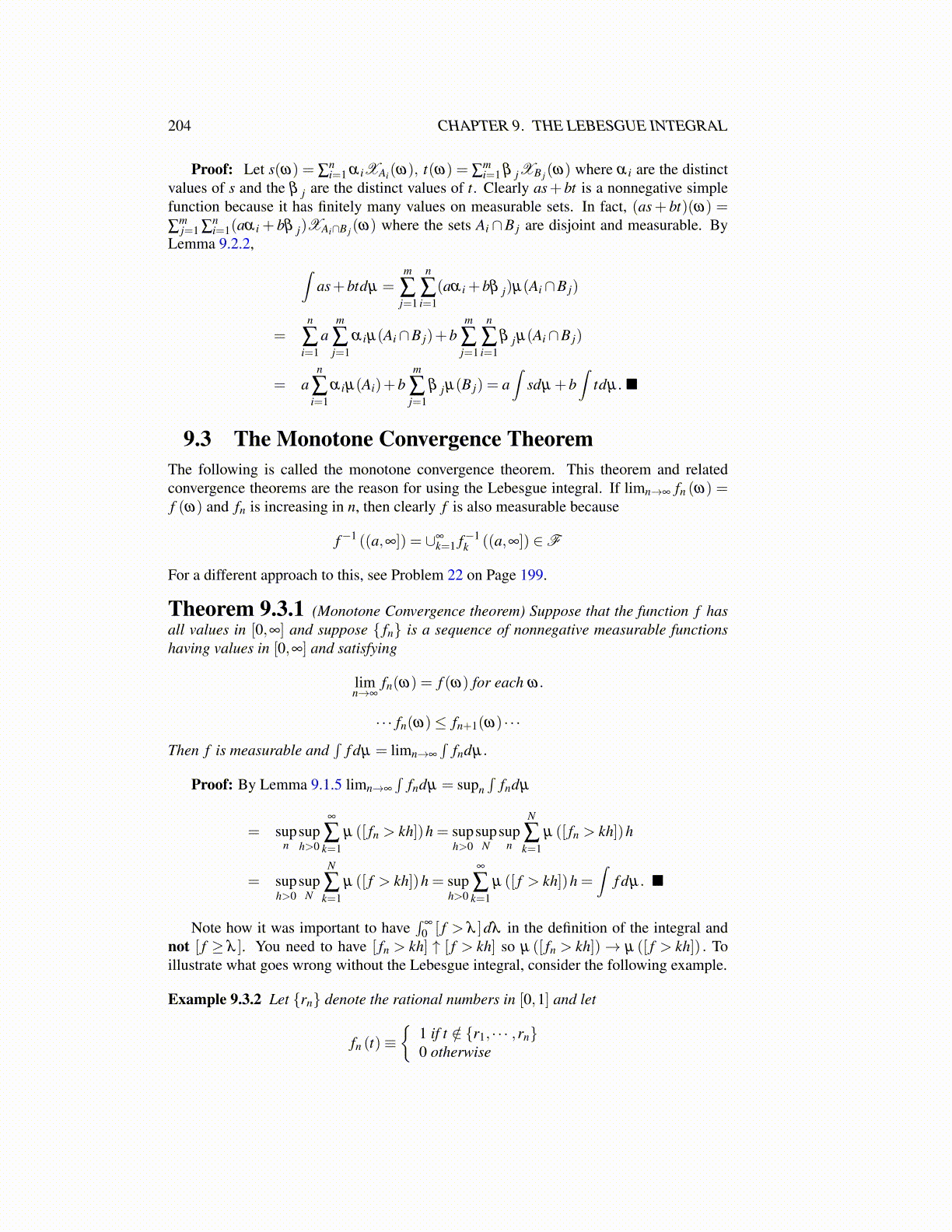
204 CHAPTER 9. THE LEBESGUE INTEGRAL
Proof: Let s(ω) = ∑ni=1 α iXAi(ω), t(ω) = ∑
mi=1 β jXB j(ω) where α i are the distinct
values of s and the β j are the distinct values of t. Clearly as+ bt is a nonnegative simplefunction because it has finitely many values on measurable sets. In fact, (as+ bt)(ω) =
∑mj=1 ∑
ni=1(aα i + bβ j)XAi∩B j(ω) where the sets Ai ∩B j are disjoint and measurable. By
Lemma 9.2.2, ∫as+btdµ =
m
∑j=1
n
∑i=1
(aα i +bβ j)µ(Ai∩B j)
=n
∑i=1
am
∑j=1
α iµ(Ai∩B j)+bm
∑j=1
n
∑i=1
β jµ(Ai∩B j)
= an
∑i=1
α iµ(Ai)+bm
∑j=1
β jµ(B j) = a∫
sdµ +b∫
tdµ . ■
9.3 The Monotone Convergence TheoremThe following is called the monotone convergence theorem. This theorem and relatedconvergence theorems are the reason for using the Lebesgue integral. If limn→∞ fn (ω) =f (ω) and fn is increasing in n, then clearly f is also measurable because
f−1 ((a,∞]) = ∪∞k=1 f−1
k ((a,∞]) ∈F
For a different approach to this, see Problem 22 on Page 199.
Theorem 9.3.1 (Monotone Convergence theorem) Suppose that the function f hasall values in [0,∞] and suppose { fn} is a sequence of nonnegative measurable functionshaving values in [0,∞] and satisfying
limn→∞
fn(ω) = f (ω) for each ω.
· · · fn(ω)≤ fn+1(ω) · · ·
Then f is measurable and∫
f dµ = limn→∞
∫fndµ.
Proof: By Lemma 9.1.5 limn→∞
∫fndµ = supn
∫fndµ
= supn
suph>0
∞
∑k=1
µ ([ fn > kh])h = suph>0
supN
supn
N
∑k=1
µ ([ fn > kh])h
= suph>0
supN
N
∑k=1
µ ([ f > kh])h = suph>0
∞
∑k=1
µ ([ f > kh])h =∫
f dµ. ■
Note how it was important to have∫
∞
0 [ f > λ ]dλ in the definition of the integral andnot [ f ≥ λ ]. You need to have [ fn > kh] ↑ [ f > kh] so µ ([ fn > kh])→ µ ([ f > kh]) . Toillustrate what goes wrong without the Lebesgue integral, consider the following example.
Example 9.3.2 Let {rn} denote the rational numbers in [0,1] and let
fn (t)≡{
1 if t /∈ {r1, · · · ,rn}0 otherwise